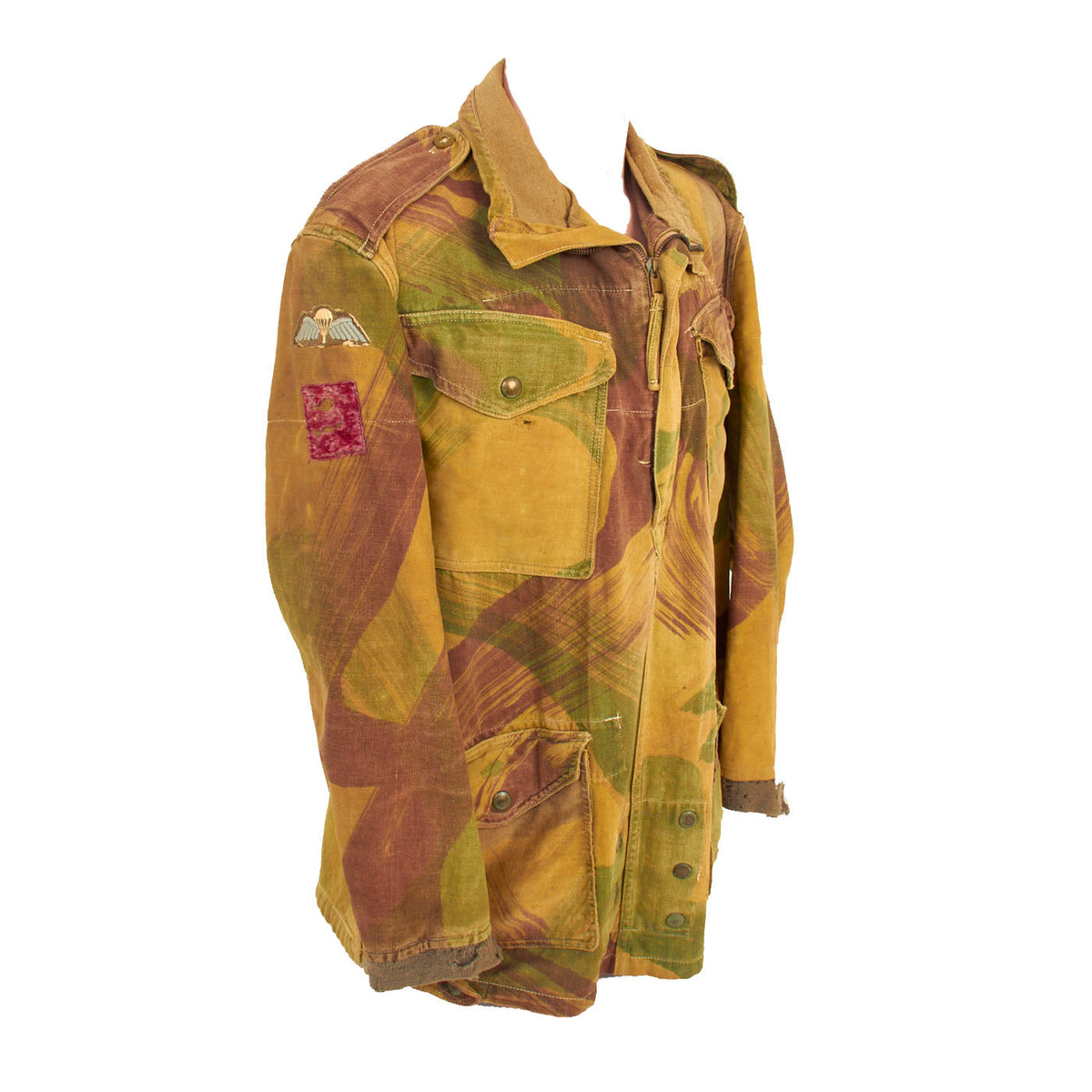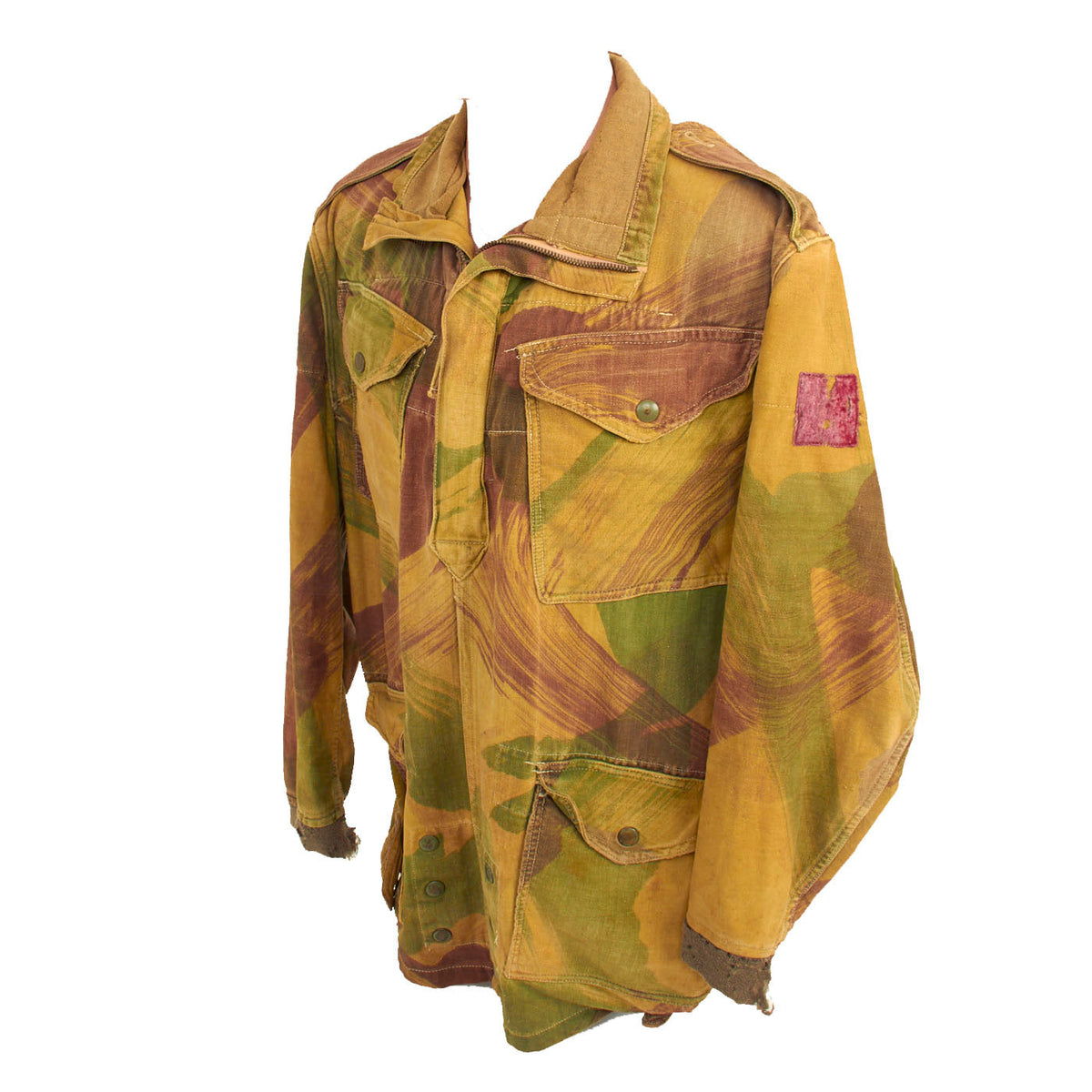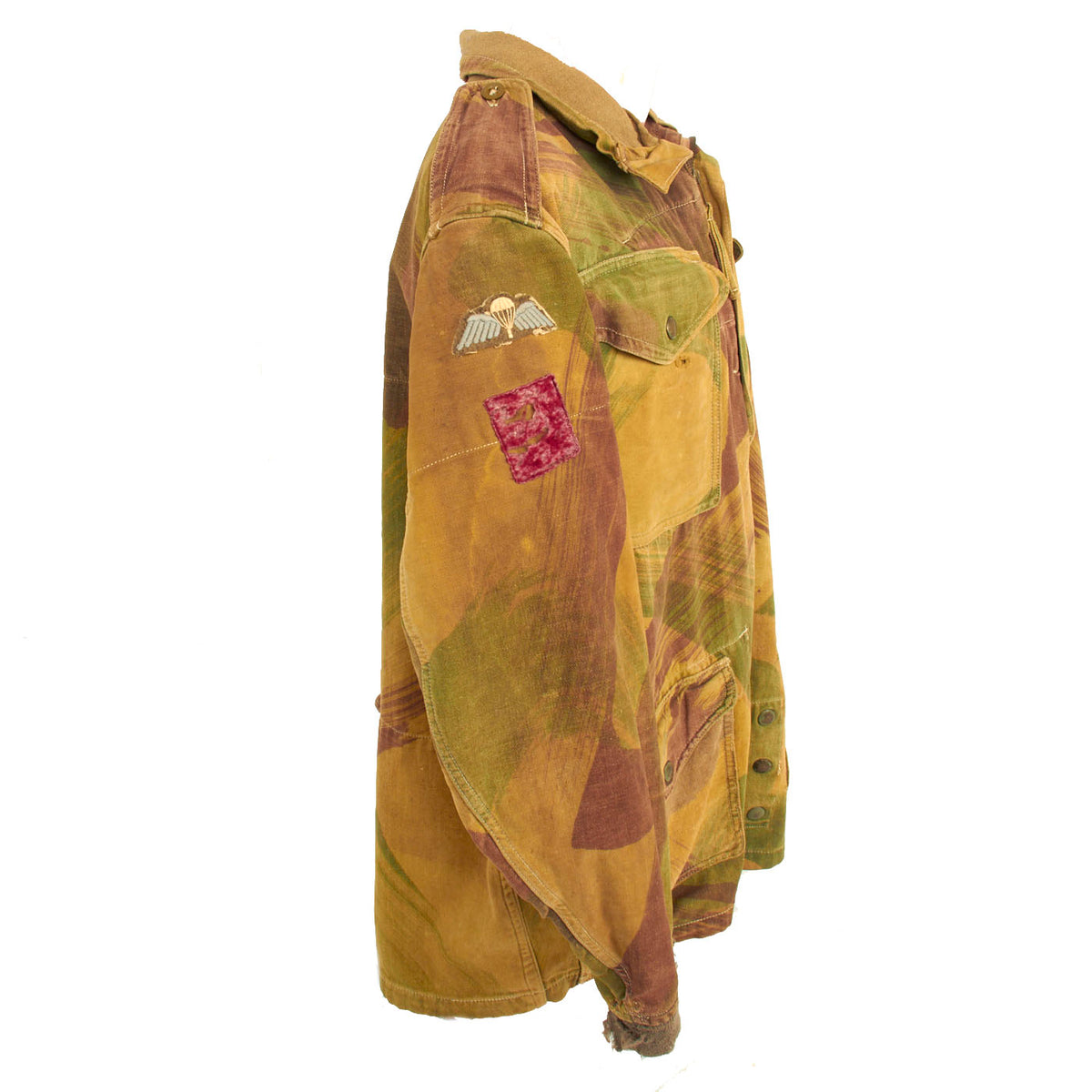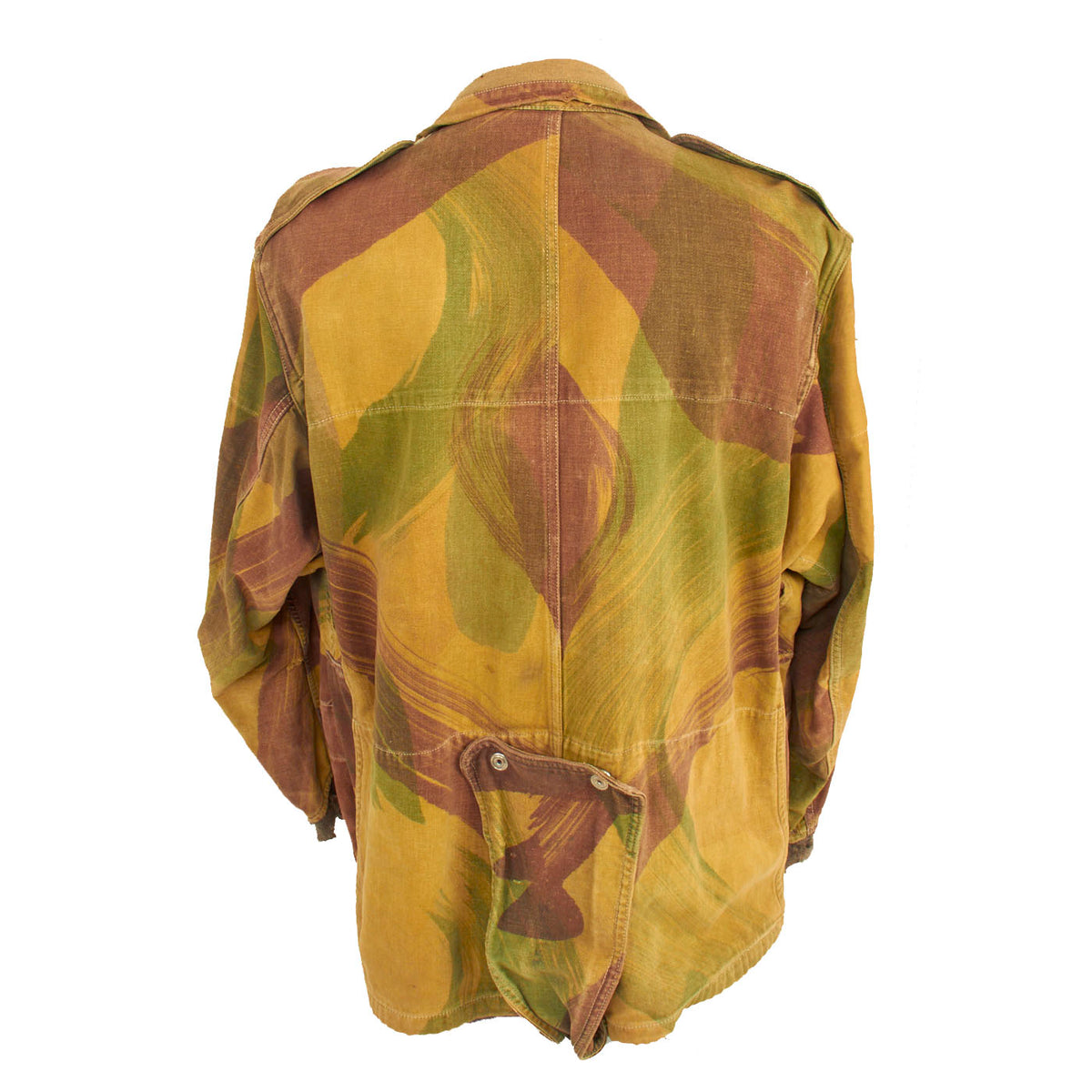Original British WWII Parachute Regiment 2nd Pattern Denison Smock With Period Applied Insignia Original Items
$ 1.495,00 $ 373,75
Original Item: Only One Available. This is a fantastic example of a genuine 2nd Pattern Denison Smock, offered in excellent, field used condition. It is in the original configuration with a function half front zipper (most were converted to full zip fronts) making this a rare find. It features brass buttons and a “monkey tail”. Size appears to be a No. 4 which is medium/large and fits up to a 5′ 8″ man. Wartime produced 1st pattern smocks are exceptionally difficult to find on the market and this will be certain to appreciate in value over time. It is faintly broad arrow stamped and no longer retains a complete tag.
Another rare feature of this smock is the correct, period applied insignia still present on both sleeves. Usually these jump smocks are found without having insignia present or replicated insignia has been applied. The original insignia includes the “Winged Pegasus” patch but the pegasus is no longer present as a result of hungry moths. The right shoulder has the same patch which also fell victim to mothing. The right shoulder retains a lovely Parachutists badge, faded but still complete.
The Parachute Badge with Wings insignia, which depicts an open parachute embroidered in white flanked by a pair of wings embroidered in light blue, is only to be worn by a qualified parachutist who has subsequently been on the posted strength of a unit where they may be ordered in the course of their duties to parachute. Those who do not serve with a parachute unit are permitted to wear the Parachute Badge without Wings, colloquially known as the ‘Lightbulb’.
This is a lovely example and comes more than ready for display!
About The Denison Smock
The Denison smock was a coverall jacket issued to Special Operations Executive (SOE) agents, the Parachute Regiment, the Glider Pilot Regiment, Air Landing Regiments, Air Observation Post Squadrons, Commando units, and other Commonwealth airborne units, to wear over their Battle Dress uniform during the Second World War.
The smock was initially worn over the paratrooper’s webbing equipment, but under his parachute pack and harness, as its primary purpose was to prevent the wearer’s equipment from snagging while emplaned or during a jump. It was equally useful for camouflage and as a windproof garment that provided a method of carrying ammunition or equipment. Contemporary photographs show that airborne troops preferred to wear the smocks under their webbing once they had landed.
The 1st pattern smock was made from loose-fitting, yellowish-sand colored, heavyweight twill material, allegedly hand-painted with broad, mop like brushes using non-colorfast dyes in broad pea green and dark brown stripes, or “brush-strokes”. With use the base color faded to a sandy buff, and the overlaid shades gained a blended appearance. The colors of the 1st pattern smock were thought to best suit the wearer to the North African and Italian theatres. It had a half length zip fastener made of steel, knitted woollen cuffs, four external pockets that secured with brass snaps (two on the chest and two below the waist), two internal pockets on the chest, and epaulettes that secured with plastic battle dress buttons. The inside of the collar was lined with soft khaki flannel (or in senior officer’s smocks, Angora wool). A “beaver tail” fastened beneath the crotch from the back to the front of the smock – which kept it from riding up during a parachute descent. When not used, the tail would hang down behind the wearer’s knees, hence the nickname “men with tails”, given by the Arabs in North Africa in 1942. The smock was styled as a very loose garment, since it would be worn over Battle Dress, but it could be adjusted to some extent with tightening tabs on both sides of the lower part of the smock.
The smock was most commonly associated with British and Commonwealth airborne units, and the Special Air Service Regiment, after D-Day, but its initial use was by members of the Special Operations Executive (SOE), parachuted or landed into enemy territory between 1941 and 1944. In the early smocks the colours were meant to be impermanent and wash out, leaving the garment looking like a typical French artisan or labourer’s chemise, and thus, hopefully, aiding the wearer’s Escape and Evasion chances. As the newly formed Airborne Forces expanded, so the need for smocks grew, meaning that they were by now screen printed for easier production.
For use by Airborne troops, the Denison was worn over the battledress and under the webbing, with a sleeveless green denim oversmock being worn over the ensemble to prevent rigging lines snagging in the webbing and causing a ‘chute malfunction. This sleeveless smock had a long external zip (often removed and used to make the half-zip Denisons full zip), a monkey tail that press studded to the outside front of the oversmock and two elasticated open pockets on the lower front which were to hold grenades for use whilst in the air or immediately upon landing. After a successful parachute landing fall, the oversmock was discarded.
Fast Shipping with Professional Packaging
Thanks to our longstanding association with UPS FedEx DHL, and other major international carriers, we are able to provide a range of shipping options. Our warehouse staff is expertly trained and will wrap your products according to our exact and precise specifications. Prior to shipping, your goods will be thoroughly examined and securely secured. We ship to thousands clients each day across multiple countries. This shows how we're dedicated to be the largest retailer on the internet. Warehouses and distribution centres can be located throughout Europe as well as the USA.
Note: Orders with more than one item will be assigned a processing date depending on the item.
Before shipping before shipping, we'll conduct a thorough inspection of the items you have ordered. Today, the majority of orders will be delivered within 48 hours. The delivery time will be between 3-7 days.
Returns
The stock is dynamic and we cannot completely manage it because multiple stakeholders are involved, including our factory and warehouse. So the actual stock may alter at any time. It's possible that you may not receive your order once the order has been made.
Our policy is valid for a period of 30 days. If you don't receive the product within 30 days, we are not able to issue a refund or an exchange.
You can only return an item if it is unused and in the same state as the day you received it. You must have the item in its original packaging.
Related products
Uncategorized
Uncategorized
Uncategorized
Uncategorized
Uncategorized
Uncategorized
Uncategorized
Uncategorized
Uncategorized
Uncategorized
Uncategorized
Angolan Rebel 1970s era 60mm Inert Display Mortar from Angolan Civil War Original Items
Uncategorized
Uncategorized
Uncategorized
Uncategorized
Band of Brothers ORIGINAL GERMAN WWII Le. F.H. 18 10.5cm ARTILLERY PIECE Original Items
Uncategorized
Uncategorized
Uncategorized













































































